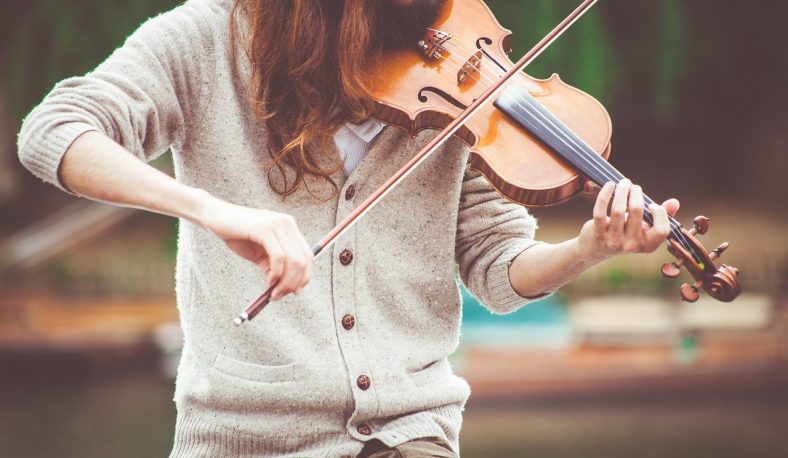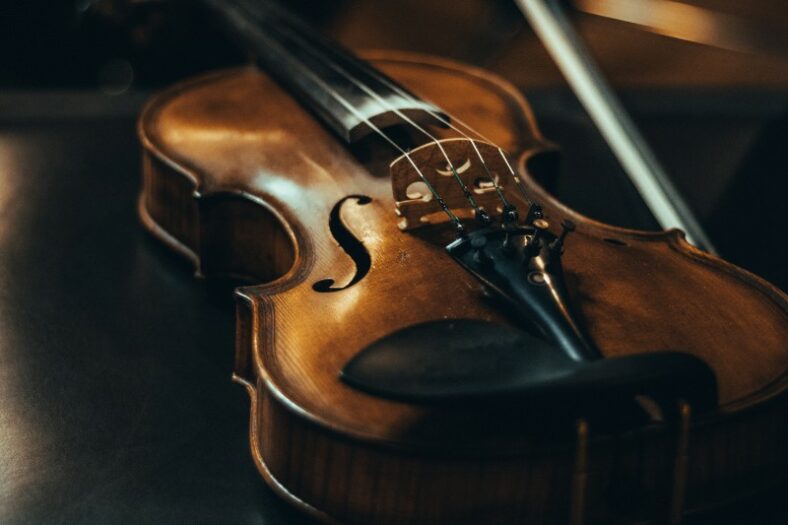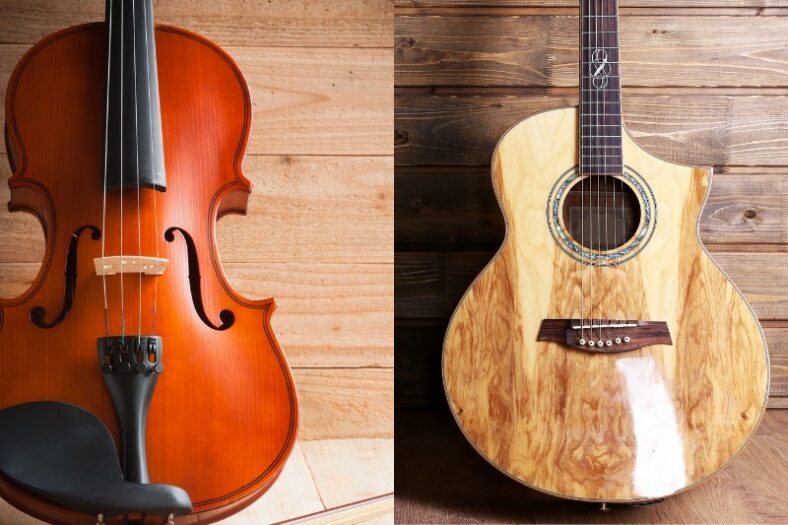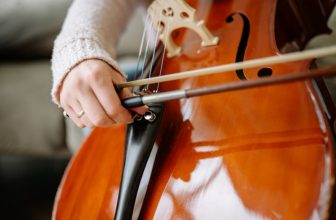Fiddle vs Violin – What are the Differences?

The fiddle and violin are the same instrument. The different terms are used depending on what style of music of being played. The term violin is used for classical music, whereas the term fiddle is more often used for folk, bluegrass, or country music.
However, there can be slight differences in instrument setup, such as strings used and bridge height.
Also, the lines can be a little blurred, particularly with musicians playing many different styles of music. In this case, they may use the terms interchangeably or simply prefer to call themselves either a violinist or fiddler out of personal preference.
Contents
Fiddle vs. Violin – At A Glance
- The Fiddle and the Violin differ in three major aspects: Bridge Height (lower for fiddles for easier playing), String Material (Fiddle – steel core strings, Violin – synthetic/gut-core strings), and Tuner (Fine tuners for fiddles, Tuning to perfect fifths for violins).
- Fiddlers tend to improvise more often since their instrument is more free-will compared to the violin which is technical, traditional, and by the book.
- Next to fiddles and violins, violas are somewhat similar and a bit larger than both. They also produce a deeper sound.
Differences in Instrument Setup

There are several substantial differences between violins and fiddles when it comes to instrument setup, which include:
Bridge Height
Fiddle players like to have a lower bridge to play multiple notes at once. Not to mention, most fiddlers use a flat-bridge setup instead of an arched one.
The reason behind such preference is that flat bridges allow for a smaller angle between the strings. This makes it easier for fiddlers to play 2+ notes at the same time.
Strings
Fiddlers have a different taste in string materials from violinists. Generally, fiddlers prefer to use steel core strings, while violinists like synthetic or gut-core strings. However, as opposed to classical violinists, electric violinists agree with fiddlers on this one.
Steel strings produce a sharper sound, making the folk-style music that fiddlers and electric violinists play sound drastically better.
Tuner
Since fiddlers usually use steel strings in their instruments, it’s a no-brainer that they’d also prefer using fine tuners. Why is that? Simply because pegs don’t work well with steel strings.
For example, if you were to move a steel E string a slight distance with a peg, chances are it won’t work out so well. That’s exactly why fiddlers save themselves the hassle by just using fine tuners on all four strings.
Per contra, many violinists use gut core strings and tune their violins to perfect fifths, so a fine tuner isn’t really necessary here. However, depending on the type of music they’re playing, fiddlers may tune their instruments to perfect fifths, too. They’d still use fine tuners, though, because they allow for more variations.
Differences in Playing Style between the Violin and the Fiddle
Playing style is probably the most significant difference between violins and fiddles.
Fiddle music is usually less complex than violin music, but that doesn’t necessarily mean a fiddle is easier to play than a violin. Fiddlers are skilled in creating the melodic lifts that people love to dance to. You’ll never be able to stay still with a fiddler rocking their best pieces of art across the room!
Violinists are more into playing classical techniques. They directly follow the sheet music from the book. In other words, a classical violinist wouldn’t make changes to how a composer intended a piece of music to sound.
On the other side of the coin, fiddlers tend to go “off-piste” a lot more. A fiddler likes to have their unique style by interpreting every piece of music in their own way. Give the same music sheet to 2 fiddlers, and they’d play it in entirely different ways.
Additionally, violinists play the instrument in a traditional way, while fiddlers may use modern techniques to alter how their music sounds. Some of these techniques include extended multiple-stop bowing passages and string bending.
Fiddle vs. Violin vs. Viola
Next to the fiddle and the violin, there’s a third instrument called the viola. A viola closely resembles the looks of a violin while being somewhat larger.
One core difference between violins/fiddles and violas is in the sound itself. Violas tend to have deeper and lower sounds than violins or even fiddles, making them a more favorable option for playing contemporary pop music. On top of that, viola players usually make their tones sound better by arching the strings with a straight bow.
Famous Violinists
Here are some of the world’s most famous violinists to have ever touched the instrument:
- Niccolò Paganini. Niccolò was an Italian artist who’s widely considered one of the most influential violinists of the 18th century. His most famous work is the 24 Caprices for Solo Violin Op. 1 compositions.
- Jascha Heifetz. Jascha’s works of art have largely influenced the music world throughout the 1900s. He’s been a violinist since he was a little kid.
- Itzhak Perlman. Itzhak has performed at some very special events. These include Queen Elizabeth’s honorary dinner at the White House and the inauguration of the 44th U.S. president Barack Obama.
- Fritz Kreisler. Fritz is widely regarded as one of the most influential virtuosos of all time. He was credited for his bold phrasing and super-sweet tone.
Notable Fiddle Players
Some of the greatest fiddle players of all time include:
- Charlie Daniels. He gained recognition when he moved to Nashville, thanks to his hit song “The Devil Went Down to Georgia”.
- Mark O’Connor. Mark won the Grand Master Fiddler Championship at the age of 13, becoming the youngest fiddler to achieve this.
- Bob Wills. Bob is widely known for his band “The Texas Playboys”.
- Craig Duncan. Craig excels in both country and classical music, inspiring an entire generation with his albums and books.
- Jay Ungar. He gained fame after releasing the Emmy Award-nominated and Grammy Award-winning theme song “Ashokan Farewell”.
Is the Fiddle Irish?
The fiddle itself isn’t Irish. However, there’s an Irish version of the fiddle, known as “Irish Fiddle” or “Celtic Fiddle”. The instrument originated in Ireland back in ca. 1160. Traces of widespread use of the instrument were found in the “Book of Leinster”.
With the exception of slow airs, Irish fiddlers rarely use the vibrato. Much of the music played on Irish fiddles is inspired by traditional Irish music, with ornaments like cuts, trebles, and rolls.
Is Fiddle Harder Than Guitar?

Yes, learning how to play the fiddle can be more challenging than learning the guitar. Here’s how:
The Use of Frets
Unlike guitars, fiddles don’t have frets. When you put your finger between 2 frets, the same note will be played no matter where exactly your finger is.
On the flip side, since fiddles aren’t equipped with frets, your finger placement plays a more prominent role here. You need to put your finger on a very specific spot on the string to play a particular note.
Beginner-Friendliness
With a guitar, you can practice some chords, and you’ll be able to play a nice song within a few days. That’s not the case with fiddles, though. It’ll take you much more time and effort to produce a consonant sound out of this instrument.
What makes things worse is that you can’t play the fiddle quietly because the bow makes the notes louder. On the other hand, you can play the guitar at variable levels of loudness by rotating between finger-picks, picks, and simply, your fingers.
Summary
To recap, the fundamental distinction between a violin and a fiddle is mostly about the type of music being played. There are a few differences in setup, but they’re more or less the same instrument at heart.
After all, you can turn a fiddle into a violin or the other way around with a few tweaks. Many violinists even use the term “fiddle” to refer to their violins in a more affectionate way, especially in the United States. The interchangeable use of both terms says a lot about how similar these instruments are!





